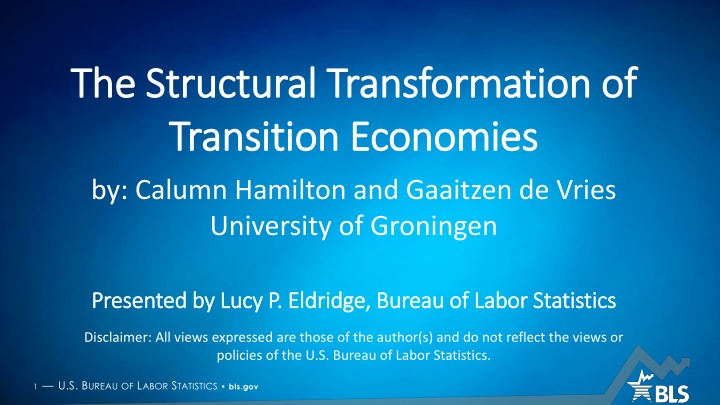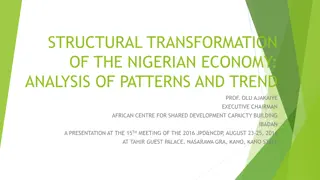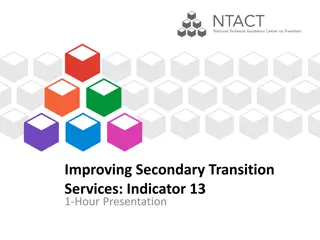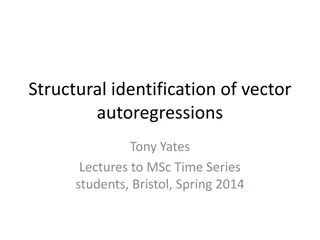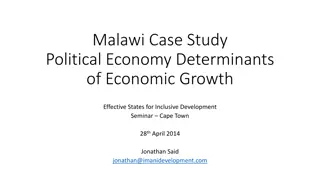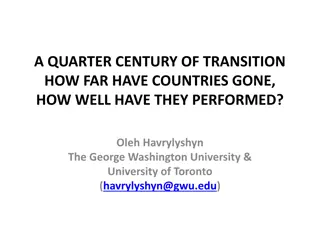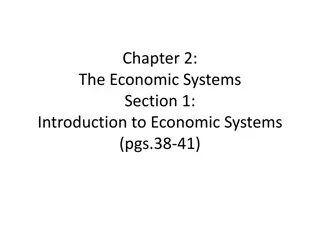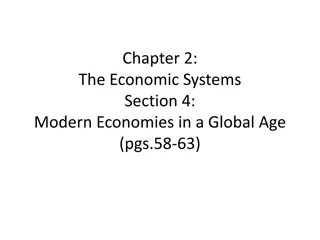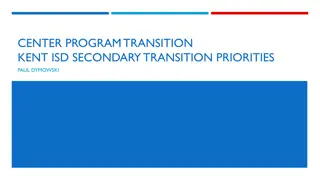The Structural Transformation of Transition Economies: Analyzing Growth and Challenges
This paper examines the structural transformation of transition economies, specifically focusing on former Soviet Union countries post-1991 dissolution. It delves into economic challenges, sectoral shifts, and the impact of marketization. The Economic Transformation Database of Transition Economies (ETD-TE) is introduced to analyze employment and value-added output trends in these regions from 1990 to 2019.
Download Presentation

Please find below an Image/Link to download the presentation.
The content on the website is provided AS IS for your information and personal use only. It may not be sold, licensed, or shared on other websites without obtaining consent from the author.If you encounter any issues during the download, it is possible that the publisher has removed the file from their server.
You are allowed to download the files provided on this website for personal or commercial use, subject to the condition that they are used lawfully. All files are the property of their respective owners.
The content on the website is provided AS IS for your information and personal use only. It may not be sold, licensed, or shared on other websites without obtaining consent from the author.
E N D
Presentation Transcript
The Structural Transformation of The Structural Transformation of Transition Economies Transition Economies by: Calumn Hamilton and Gaaitzen de Vries University of Groningen Presented by Lucy P. Eldridge, Bureau of Labor Statistics Presented by Lucy P. Eldridge, Bureau of Labor Statistics Disclaimer: All views expressed are those of the author(s) and do not reflect the views or policies of the U.S. Bureau of Labor Statistics. 1 U.S. BUREAU OF LABOR STATISTICS bls.gov
Objectives of the Paper Analyze growth and structural transformation in the former Soviet Union (FSU) countries, after the USSR was dissolved in 1991 Introduce a new database - Economic Transformation Database of Transition Economies (ETD-TE) Compare structural change in FSU countries and other formerly central planned economies of Central and Eastern Europe (CEE) and other developing regions 2 U.S. BUREAUOF LABOR STATISTICS bls.gov
14 Former Soviet Union (FSU) Countries Core (Soviet-centre): Belarus, Moldova, Russia, and Ukraine Central Asia: Kazakhstan, Kyrgyzstan, Tajikistan, and Uzbekistan Caucasus (South region): Armenia, Azerbaijan, and Georgia Baltics (Baltic coast): Estonia, Latvia, and Lithuania Turkmenistan is not included 3 U.S. BUREAUOF LABOR STATISTICS bls.gov
Challenges for Independent FSU Countries Rapid dismantling of central planning and shift toward marketization and privatization Financial instability due to price liberalization (periods of hyperinflation) and the shift away from a single currency Imbalances across FSUs Endowment of natural resources Composition of economic sectors And sector productivity 4 U.S. BUREAUOF LABOR STATISTICS bls.gov
Economic Transformation Database of Transition Economies (ETD-TE) Employment and Value-added output, 1990-2019 14 former-Soviet Union countries 12 sectors following ISIC Revision 4 Designed to be consistent with EU-KLEMS and the Economic Transformation Database for developing countries of Africa, Asia, and Latin America Publicly available with attribution, www.ggdc.nl 5 U.S. BUREAUOF LABOR STATISTICS bls.gov
ETD-TE Construction, Consistency and Reliability Constructed using primary and archive statistical sources Focused on data consistency Intertemporal complete, expressed in consistent units, and no structural breaks International industrial classification, international standard definitions and same base year Internal value added and employment cover same sectors of the economy Transparent about data reliability Limitations in primary data sources, including lack of price data prior to marketization Changes in data collected and shifts in reporting biases 6 U.S. BUREAUOF LABOR STATISTICS bls.gov
Structural Changes Role in Productivity Growth Fabricant s shift-share decomposition of aggregate labor productivity growth ??= ?=???,? ? ??,? + ?=???,? ??,? sector productivity growth structural change Sector productivity growth - reflects technological progress, capital intensification, technical efficiency growth originating within sectors of economy Structural change - captures contribution of workers reallocating between sectors, to sectors with higher or lower initial productivity Y aggregate productivity, yi sector i productivity growth, employment shares 7 U.S. BUREAUOF LABOR STATISTICS bls.gov
Productivity Decomposition for FSUs by Sub-regions 1990-2019, average annual growth (Figure 6) Contribution of structural change in FSUs was negative; reallocation of workers to lower productivity sectors FSU Countries Growth reducing structural change was largest in Caucasus which also had largest within sector productivity growth Core Central Asia Caucasus Baltics Baltics experienced positive structural change; reallocation of workers to higher productivity sectors -1.5 -1.0 -0.5 0.0 0.5 1.0 1.5 2.0 2.5 3.0 3.5 4.0 4.5 5.0 Sectoral productivity growth Structural change 8 U.S. BUREAUOF LABOR STATISTICS bls.gov
Productivity Growth for FSUs and Sub-regions, by Decade 1990-2019 average annual growth (Table 3) 8.5 6.5 4.5 1990-1999 2.5 2000-2009 0.5 -1.5 2010-2019 -3.5 -5.5 FSU Core Central Asia Caucasus Baltics Countries 9 U.S. BUREAUOF LABOR STATISTICS bls.gov
Productivity Decomposition for FSUs by Decade 1990-2019, average annual growth (Table 3) Growth reducing structural change in FSUs was concentrated in the first decade of transition 1990-2019 Within sector productivity was also negative from 1990- 1999 1990-1999 2000-2009 Both within sector and between sector contributions were positive after 2000 2010-2019 -3.0 -2.0 -1.0 0.0 1.0 2.0 3.0 4.0 5.0 Sectoral productivity growth Structural change 10 U.S. BUREAUOF LABOR STATISTICS bls.gov
Productivity Decomposition by Decade and Sub-region 1990-1999 -1.78 -1.24 -3.02 -4.17 -0.17 -4.34 0.66 0.60 1.26 -0.08 -2.60 -2.68 -2.49 -2.65 -5.14 2000-2009 4.75 0.41 5.16 4.18 0.32 4.50 3.50 0.45 3.95 8.52 0.43 8.95 3.45 0.46 3.91 2010-2019 2.17 0.18 2.35 3.08 -0.19 2.89 2.04 0.09 2.13 2.63 0.39 3.02 1.01 0.48 1.49 Within Between Total Within Between Total Within Between Total Within Between Total Within Between Total FSU Countries Core Baltics Caucasus Central Asia 11 U.S. BUREAUOF LABOR STATISTICS bls.gov
Productivity Decomposition for Baltics by Decade 1990-2019, average annual growth (Table 3) Baltics experienced transition differently from other FSUs 1990-2019 Growth enhancing structural change was largest in the first decade of transition 1990-1999 Within sector productivity was smallest in the first decade 2000-2009 2010-2019 0.0 0.5 1.0 1.5 2.0 2.5 3.0 3.5 4.0 4.5 Sectoral productivity growth Structural change 12 U.S. BUREAUOF LABOR STATISTICS bls.gov
Comparisons of Structural Change with Other Economies Baltics the only FSU countries that experienced growth enhancing structural change and later joined the European Union FSU* denotes FSU countries excluding Baltics CEE 8 former Warsaw pact countries of Central and Eastern Europe (1995-2018) Developing Regions Asia, Latin America, Sub-Saharan Africa (1990-2018) 13 U.S. BUREAUOF LABOR STATISTICS bls.gov
Productivity Decomposition: FSU*, Baltic and CEE Countries 1995-2018, average annual growth (Figure 1) Central & Eastern Europe (CEE) countries experience growth enhancing structural change FSU* Within sector productivity growth in FSU* (excluding Baltics) was more than double that of CEE Baltics CEE Baltics experience is similar to CEE countries -1 -0.5 0 0.5 1 1.5 2 2.5 3 3.5 4 4.5 5 Sectoral productivity growth Structural Change 14 U.S. BUREAUOF LABOR STATISTICS bls.gov
Initial Employment Shares and Shifts FSU*, Baltic, and CEE Countries (Table 2) 1995 Employment Shares by Sector Shifts in Employment Shares 1995-2018 percentage point change FSU* 33.4 19.7 14.4 11.4 5.5 4.6 Baltics 15.0 22.2 19.1 16.7 6.2 7.3 CEE 17.4 18.2 24.1 14.2 6.4 5.8 Agriculture Agriculture Public Sector Manufacturing Trade Construction Transport Manufacturing Other Industry Public Sector Other Services Transport Construction Finance & Business Other Industry Other Services Finance & Business 3.8 3.7 3.4 7.0 3.2 3.3 7.4 3.7 2.9 Trade -9 -6 -3 0 3 6 CEEs FSU*s Baltics 15 U.S. BUREAUOF LABOR STATISTICS bls.gov
Initial Employment Shares and Shifts FSU*, Baltic, and CEE Countries (Tables 1 & 2) 1995 Productivity Mean Ratio by Sector Shifts in Employment Shares 1995-2018 percentage point change FSU* Baltics CEE Agriculture Agriculture Manufacturing Other Industry Public Sector Other Services Transport 47 36 78 42 71 Manufacturing 125 359 103 100 136 Other Industry 260 119 107 158 243 133 139 129 Public Sector Other Services Transport Construction Construction Finance & Business Trade 122 455 101 100 160 86 117 218 91 Finance & Business Trade -9 -6 -3 0 3 6 CEEs FSU*s Baltics 16 U.S. BUREAUOF LABOR STATISTICS bls.gov
Productivity Decomposition: FSUs and Other Developing Regions 1990-2018, average annual growth (Figure 5) FSUs are the only developing region which experienced growth reducing structural change FSU (2019) Developing Asia (ASIA) and sub- Saharan Africa (SSA) experienced structural change which added a substantial contribution to their aggregate labor productivity growth ASIA Latin America SSA The contribution of structural change in Latin America was non- negative -1.0 -0.5 0.0 0.5 1.0 1.5 2.0 2.5 3.0 3.5 4.0 4.5 5.0 Sectoral productivity growth Structural change 17 U.S. BUREAUOF LABOR STATISTICS bls.gov
Key Findings Structural change in FSU*s (except Baltics) contributed negatively to productivity growth The negative contribution of structural change was largest in first decade Structural change was growth enhancing in Baltics, CEE, and other developing regions Within-sector productivity growth in FSU* countries, exceeded that of CEEs and Baltics, and most other developing regions studied Differences in contributions of structural change to productivity growth can be attributed to the interactions of initial conditions, external factors, and reform strategies between FSU*s and other countries 18 U.S. BUREAUOF LABOR STATISTICS bls.gov
Discussant Comments Congratulations on an impressive new data set! Greatly appreciate the authors transparency on assumptions and limitations of the data, especially for 1990-1995. Consider: Replicating all comparisons for 1995 forward Would it be possible to simulate the Soviet NMP for 1995 forward to assess reliability of backwards extrapolation? Could small area estimation be useful? Literature references concerning causalities, initial employment, and value added shares were helpful. Is it possible to provide more description of differing economics and political conditions in FSU and CEE countries prior to 1990? Is it feasible for future research to include capital and TFP measures? 19 U.S. BUREAUOF LABOR STATISTICS bls.gov
Comparing impact of 1995-2018 period, FSU* (excluding Baltics) and Baltics FSU 1990-2019 FSU* 1995-2018 Baltics 1990-2019 Baltics 1995-2018 -1 -0.5 0 0.5 1 1.5 2 2.5 3 3.5 4 4.5 5 Sectoral productivity growth Structural Change 21 U.S. BUREAUOF LABOR STATISTICS bls.gov
